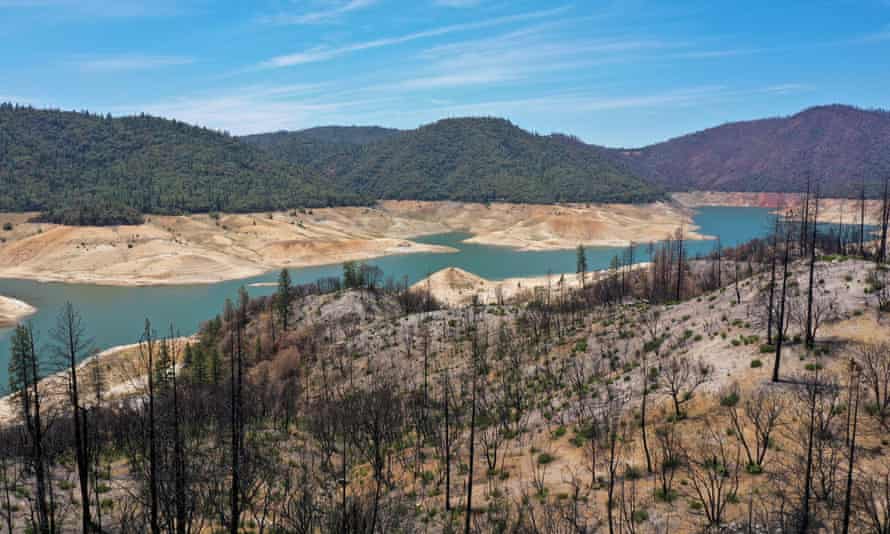Earlier this month, the water level in Lake Oroville – California’s second-largest reservoir – was so low that dozens of houseboats were hauled out. There wasn’t enough water to hold them.
In a few weeks, officials say, the lake’s water levels are likely to dip even lower – forcing them to shut down one of the state’s largest hydroelectric power plants for the first time since it was built in 1967.
Amid a historic megadrought, the climate crisis and energy crisis in California are about to collide, and set off a vicious cycle. The state’s diminishing water supply is cutting down hydropower, and California is relying more on fossil fuels as extreme summer heat drives up electricity use.
“This situation really highlights the ways in which climate and energy and water are all very tightly linked,” said Noah Diffenbaugh, a climate scientist at Stanford University. With meteorologists anticipating a hot, fiery summer, experts say that cuts to hydropower will increase pressure on the state’s already-stressed power grid, as residents across the region crank up their air conditioners. And as drought desiccates the west, the state’s increasing reliance on gas-fired plants could also compromise its goal of transitioning to carbon-free electricity.
Hydroelectric plants generate electricity from water as it is channeled to farms and cities, harnessing flowing water to power turbines. But as water levels at Oroville and other major reservoirs dip, the amount of power generated from outflows has been cut in half. The Hoover dam at Lake Mead, the largest US reservoir, has reduced its generation capacity by about 25% due to low water levels. So far this year, hydropower has accounted for just 7% of the power generated in California.
“California isn’t completely dependent on hydropower,” explained Stephanie Pincetl, the founding director of the California Center for Sustainable Communities at UCLA. “But less water and less hydropower does mean more natural gas or coal.”

That’s because gas-fired power plants are still the easiest, most reliable way to add electricity to the grid. Although the state has been ramping up its renewable energy production, especially from solar and wind power, it lacks the infrastructure to store energy from these sources for long enough to reliably keep residents’ power running through the hottest months. “In order to build a more resilient grid, we need a lot more renewable generation and we need battery storage,” Pincetl said. The state’s goal of building a carbon-free power grid by 2045 makes such improvements especially imperative, she said.
Diffenbaugh and his colleagues found that shifts in energy sourcing during the west’s last prolonged drought drove up carbon dioxide emissions from power generation by an additional 100m tons of carbon dioxide across 11 western states between 2001 and 2015. Another study, published last year, found that lost hydropower generation cost California $1.9bn during the previous drought, as it and other western states turned to natural gas or coal to keep the lights on.
Already this year, the California ISO, which operates the grid in most of California, has asked residents to conserve power to avoid triggering brownouts and shortages during the record-breaking heatwave earlier this month. The demand for power is likely to continue to increase throughout the summer, just as the state’s hydropower capacity cuts out. A heatwave overwhelmed California’s power grid last August, triggering the first power shortages since the 2001 energy crisis, when power traders deliberately manipulated power supplies.
In the coming decades, as climate change continues to exacerbate hot, dry conditions, the state will also have to grapple with the use of water for cooling nuclear and natural gas power plants. Although many thermal power plants in California recycle water used for cooling, some power plants, especially in the Central Valley, still rely on using surface water, and are vulnerable during droughts, the Public Policy Institute of California found.
“Our systems and infrastructure were designed and built in previous decades, to work in our old climate,” Diffenbaugh said. “As the Earth gets warmer, triggering extreme conditions, those systems are getting stretched – unfortunately beyond their capacity.”